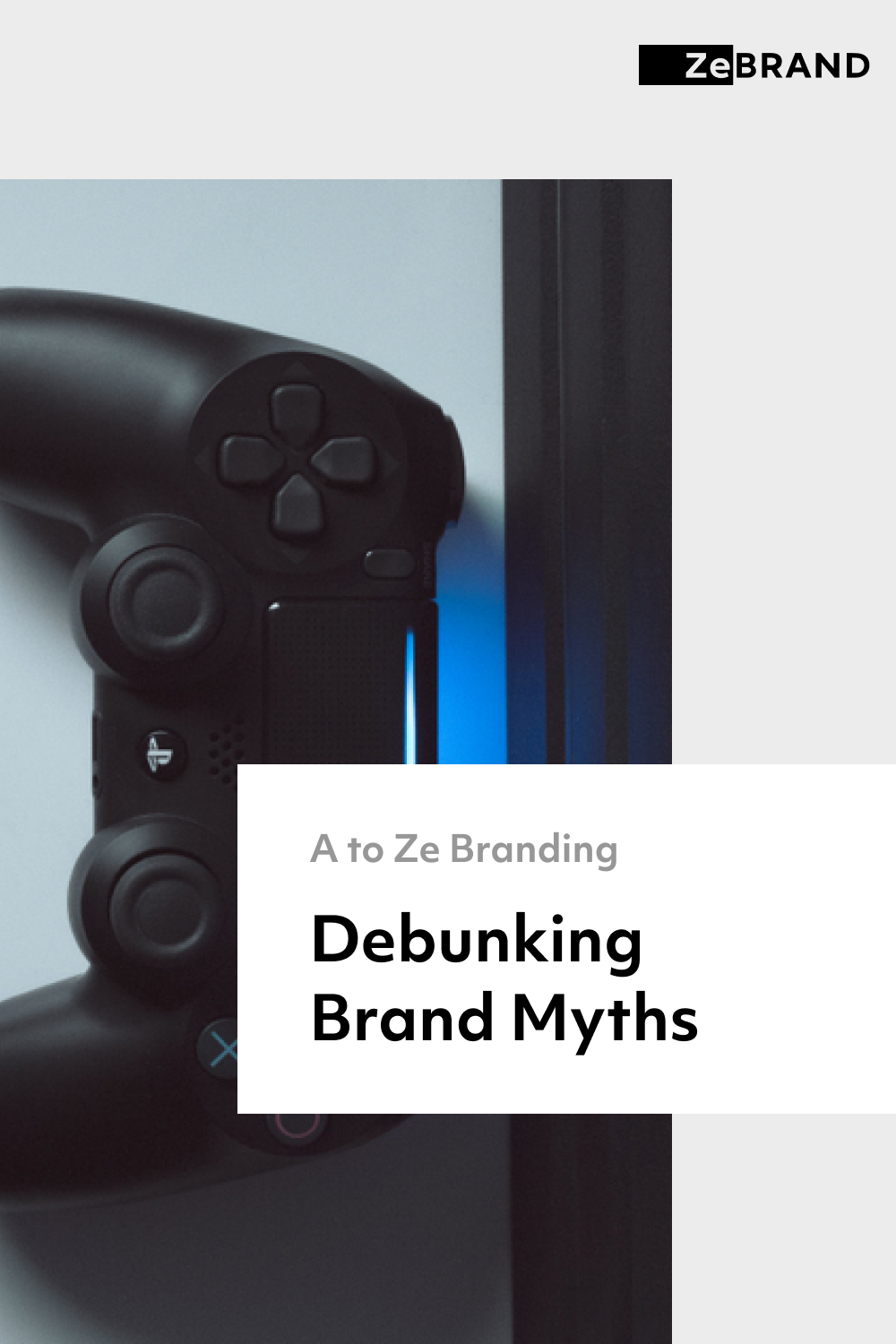Debunking Brand Myths

Myth One: Branding is the story you tell people to sell your product.
At ZeBrand, we believe your vision deserves to be seen and realized. In this content series, we help you use brand as a tool to power up your business and jumpstart your growth.
Welcome to Part 9 of A to Ze of Brand Building -- 'Debunking Brand Myths'. (Read Part 8 here if you missed it!)
-----
Branding has the power to drive real change. It can help bring social issues like sustainability to the fore, or provide people with products and services that will make an instrumental difference to their lives. As a tool, it’s just like any other. It can be wielded for good.
To make the most out of your brand though, we all have to understand its full potential. Unfortunately today, we’re not quite there yet. There are plenty of misunderstandings about brands, its purpose, and its applications.
So here are the top four myths about brands and how we might go beyond them to unlock the full value of what your brand can achieve and offer.
Myth One: Branding is the story you tell people to sell your product.
‘Brand is a story’. A lot of people think that a brand is a marketing technique for driving purchase behavior, or that it’s the creative expression that reels in business and profit.
Although not entirely wrong, this is a better description of advertising as a discipline than it is a definition of branding. Advertising is a discipline built around “selling” a story to instill desire in people’s behaviors, the end-goal often being to drive people towards what’s called a ‘sales funnel’: the journey from awareness of a brand or product, all the way to its ultimate purchase. Advertising can take many forms — a poster showing a dynamic image of a set of next-generation noise-cancelling headphones, a TV ad that amplifies your favorite snacks in a new, exciting flavor, and, increasingly, more subtly-marketed content that look more like high-end films or good pieces of writing rather than traditional commercials.
While advertising revolves around the short-term goal of “selling”, branding aims for something much more long-term. It digs deeper within audiences to reach more than just desire — it aims to instill loyalty, trust, and belief. By allowing consumers to form an emotional investment with not just products, but the entire essence of the company itself, it creates a stronger following and bond between business and consumers. In other words, if advertising is a single chapter in your brand’s story, your brand is the underlying trilogy.

Myth Two: Branding is about design, not business.
How many times have you heard “A brand is more than just a logo?” This speaks to a great number of people who hold the perception that brand is an entirely creative endeavor that sits separately from management, financials, research, and development. That it is simply, artistic.
This is entirely misguided. Branding is bridging the intersections of business, research, design, and strategy, all under one roof. Every visual design decision is informed by a business decision, piece of research or strategy, or all of the above. This is why more and more businesses are recognizing that businesses themselves can be “designed”. Fields like Design Thinking, Business Design and Design Innovation explore how techniques and thinking used by designers to solve problems can be similarly used by business leaders and planners to achieve their goals as well. What it shows is that not only do the worlds of strategy and design overlap, design can be used to supercharge business processes.
As a concept, this can seem quite contradictory. What’s more, business managers and creatives traditionally employ very different ways of thinking and communicating. But branding allows both sides to share and look through the same lens. This lens includes concepts like ‘positioning’, ‘values’, ‘messaging’, ‘core idea’, ‘attributes’, and ‘principles’ — all of which are understandable by both business and creative sides in the branding process.
Myth Three: Branding is just the wrapper.
Another common misbelief is that ‘brand is the wrapper’— it’s simply design work that comes after the ‘real’ process of building a business is done; it’s the cherry on top, or the fluff around the substance.
The reason for this misbelief is that a part of branding is about enhancing the visual footprint of a company, product, or service. In branding, we often harness symbols, colors, and language by combining them in an impactful way that draws attention. But just because it’s about presentation or appearances, it doesn’t mean there’s no substance beyond the surface. Every visual brand element ties back to support and reflect the business strategy. The way in which a company chooses to present itself is a business decision that is informed by a combination of research, strategy, and data to provoke the right emotional response from an audience.
And if brand design is designed around provoking an emotional response, it must veer even deeper under our skins, into the psychological and behavioral realms of understanding people. As evidenced by the waiting lines that form outside the Apple store when the latest iPhone is released, or the outcries when our favorite drink or snack is discontinued, our emotions drive our behavior more than we realize. In fact, behavioral economics is a field that revolves around updating our understanding of how people make decisions and in doing so, lends a lot of credence to the fact that branding is more than just the wrapper. In fact, without emotion, we wouldn’t be able to make decisions at all.

Photo by Jeremy Perkins on Unsplash
Myth Four: Branding is about making companies more powerful and influential.
We can’t deny that corporations have an impact on our quality of life far beyond just the products and services they offer. And as of late, they’ve been subject to plenty of scrutiny. From large oil spills to safety issues, mass product recalls to impacts on mental wellbeing, the ripple effects of business activity impact almost every aspect of our personal lives. Because of this, branding is often seen as a sneaky tool for giving powerful companies the power to manipulate public opinion and increase their corporate influence. This is not entirely false: When used wrongly, companies wield brand as a tool for spreading and covering up for evil deeds. But many companies also wield their brands as a force for good. More and more, corporate leaders are stepping forward and making their brands synonymous with societal betterment, using their positive influence to do their parts.
For instance, ‘Green’ products’ have traditionally been deemed as of lesser quality, a product of compromise. But through branding, the ideas around sustainability can be used to rally employees and customers around an ethical cause that is as emotionally engaging and gleaming with quality as it is sustainable. Adidas, for example, has partnered with Parley to produce coveted sneakers with uppers made from plastic found in the oceans. By turning trash into products, they are not only sustainably producing internally, but spreading consumer awareness of plastic pollution in our oceans. Patagonia too has made a commitment in its very purpose to do everything it can to support the environment and has run advertising campaigns to actively ask people not to buy some of its products, because mindless consumption and buying more than needed only contribute to unsustainable waste and landfills.
The positive influence of brands, of course, extends beyond environmental causes. TOMS has a “One-for-One” purchase model in which buying a pair of shoes, eyeglasses, or a bag of coffee beans provides a matching donation of shoes, eye treatment, or water to people in developing countries. Nudie Jeans also goes through lengths to provide living wages or increased wages for their workers who are involved in the production of its jeans.
Branding has long been pigeon-holed as a discipline that deals largely with making things “appealing” after the important work has been done. And because of that, people may be led to believe that branding is peripheral at best, or even downright deceiving. But this is far from the truth. The world is realizing that precisely because of its visibility, branding can be used to re-focus people’s energies on making ethical choices in their consumption habits, buying into a cause or belief for good, and even going as far as to make a positive impact. And as business leaders and people who form brands, this is the responsibility we have to deliver on.

A to Ze of Brand Building is a 10-part series about all things branding, with an eye to using branding to engage your customers and grow your business. Continue on to Part 10: Evolving with the Times.


